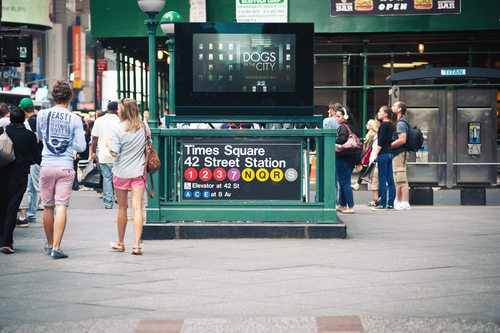Why DOOH is the future of outdoor advertising?
By Scott Brown
Out of home advertising has always been a great tool for reaching out an audience that is away from radio, television, and magazines. People that are traveling are the prime targets of this form of advertising.
Digital out of home is the digitized version of the same and aims to reach out to people who are at railway stations, bus stops, restaurants, highways, schools, malls…basically anywhere with footfalls.
People search when on the move. One out of four Americans in the 18-34 years age group searches when on the street. A similar percentage does so in buses, trains, and cars. And there is an equal number of people shopping on their mobiles. These stats present a unique picture of a huge opportunity to engage with this demographic in a meaningful manner. DOOH, and more specifically, interactive DOOH, makes this possible.
OOH is not a new thing, it has been around forever in the form of billboards. Marketers already have great understanding of how to communicate outdoors. But with technology going digital, the scope for reaching out in different ways has increased. Businesses can now communicate with people outside in an unfettered manner and the interaction can go on for days, outside the home and inside. Once DOOH begins a communication with an individual, it can be sustained through email, SMS, telephone, social media, and even offline magazine subscriptions.
Urbanization is playing a big role in the proliferation of DOOH. The technology is now available in small towns and places that were once considered the backwaters. DOOH provides actionable information when most required. It answers questions and also serves to make an audience aware of their needs.
DOOH can integrate with online advertisements. Businesses can weave narratives via online ads and DOOH and reach out to customers offline and online. The best thing about DOOH is that relevant information exchange happens. The consumer is able to share insight and observations.
For advertisers, OOH offers the opportunity to invest in a medium that offers an attractive ROI and the chance to break into new markets. Whatever the advertising objective – from brand awareness to sales – it can be fulfilled through DOOH. In 2019, advertisers in locations such as Singapore and London will see more than 50% of their out-of-home advertising revenue coming from DOOH. This bodes extremely well for advertisers who wish to invest in DOOH as a part of their overall marketing campaign.
Since consumer concentration is based in urban areas, it makes sense to focus OOH efforts on urban agglomerations. Urbanized people move about. There are opportunities to connect with the masses going to work, coming back from work, and those stepping out for multiple reasons. Each and every business type has the chance to place itself in front of a viewing audience and stimulate engagement. This is true for B2B and B2C companies.
This mobility that arises from an urban lifestyle leads to newer ways of consuming information and accessing technologies. Advertisers with the savvy to understand this vital point can steal a march over their competitors. Consumers today would rather be exposed to advertisements outside their homes rather than inside. Advertisers need to be in sync with such customer mindset.
As far back as 2011, one of three people exposed to an OOH ad ended up searching online. Today, the number approaches 60% and higher with the use of DOOH, especially interactive DOOH.
If an advertiser wishes, he can use DOOH to send traffic to social media or make the traffic converge onto a website landing page. It’s up to you. This is because DOOH is a tech-driven platform that can be easily integrated with the internet. This increases the chances of having a meaningful conversation with the prospect. It can be done on social media or through email. Once you throw internet into the mix, then you have nudged the prospect down the sales funnel. You can place a DOOH communication anywhere on the buyer’s path. You can target fresh prospects, communicate with raw leads, or reach out to existing consumers.
The billboards of yesterday are touch-sensitive screens of today. Information can be broadcasted from mobiles and wearable technology to DOOH signage and the appropriate message can be displayed for the consumer.
The proliferation of DOOH is also being facilitated by the cheaper availability of digital signage technology.
According to PQ Media, the exposure time of the masses to DOOH has grown from 7 minutes in a week in 2007 to 20 minutes in 2017. This means advertisers are putting in money into DOOH and digital signage systems are increasingly being deployed. This is happening because the technology is giving them the returns on investment.

